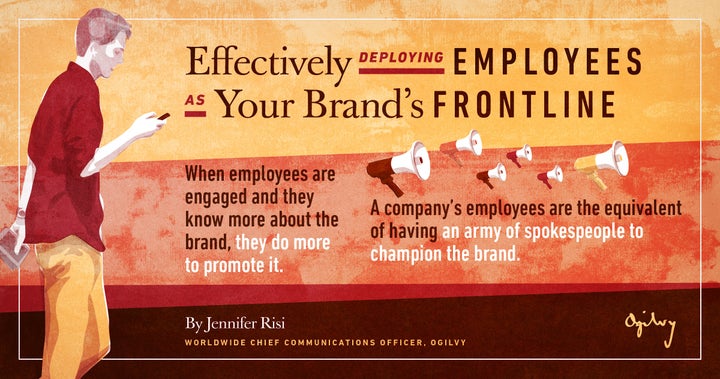Having a strong brand identity is vital when it comes to driving any business. Yet often times companies overlook or underutilize one of their most valuable brand-building assets…their employees.
Brands rightly invest a great deal of time and resources into developing a brand identity and creating a brand experience that resonates with their clients or customers. And who better to provide consumers with insight into a company’s brand than its employees? Employees can be an extremely powerful tool to help drive a company’s brand because they are the very people who live the brand experience every day. What’s more, when leveraged properly, employees can become brand ambassadors who help increase a company’s bottom line. How, you ask?

A company’s employees are the equivalent of having an army of spokespeople to champion the brand on a regular basis. The key to making sure they are reinforcing the right brand message is helping them understand the company’s products and/or services and ensuring they have the same brand experience that you want for your consumers. That means communicating with employees in a way that reflects your brand’s values.
The way a company communicates with its employees is often reflected in how employees share (or don’t share) the company’s brand experience with the world. If employees are not engaged, they simply become an untapped resource for brand reinforcement. This is an area where most companies have huge growth potential. In February 2017, Gallup released its “State of the American Workplace” report, which found that the U.S. – and the world at large – is “in the midst of an employee engagement crisis.” According to the report, the majority of employees (51 percent) are not engaged, which has been a steady trend over the last decade and a half, where employee engagement has either stagnated, or in some years, even decreased. In fact, the report found that from 2012 to 2016, employee engagement increased by only three percentage points.
One of the first things employers can do to help increase employee engagement is examine whether or not employees are armed with the information they need to effectively communicate the brand message. It’s also important that employees feel invested in the brand. This happens through frequent and consistent internal communication. Communicating regularly with employees makes them feel knowledgeable, valued and personally connected to the brand. This reinforces the brand values that you want consumers to experience.
Here’s where modern advancements in technology provide employers with opportunity. Today, social media and smart phones provide employers with the biggest opportunities for employees share their employer’s brand experience. This is particularly true as more and more millennials – many of whom are highly active on social media – enter the workforce. Having employees use social media to share positive brand experience can actually impact a company’s bottom line. A recent article in the Boston Globe explains how. Encouraging employees to share news about the brand equates to earned coverage, which saves companies money on advertising and paid social engagement, while increasing the potential consumer base through positive brand reinforcement. It’s even better when employees decide to share positive brand experiences on their own because they are inherently connected to the brand.
The question then becomes: how do companies get employees to be more informed and more engaged so that they are motivated to become brand champions? A simple answer is to create an internal brand experience that’s reflective of the company’s external brand. We certainly know this is sometimes easier said than done – particularly with large global organizations. However, Forbes recently shared a great article, Seven Simple Steps To Turn Your Employees Into Brand Ambassadors, which listed solid recommendations that companies can implement. And now is a great time for companies to refresh their internal communications strategies, keeping their brand identity in mind, as we move toward the New Year. One thing to add to the recommendations listed in the Forbes article is to strengthen the pool of brand ambassadors by investing even more into recruiting and communicating with the next generation of talent who will be promoting the brand. According to a report by The Brookings Institution, millennials will make up approximately 75 percent of the workforce by 2025. It makes sense for companies to develop internal branding strategies that align with the expectations of the majority of the incoming workforce. This builds a solid foundation for the next wave of brand ambassadors.
Earlier this year, Ogilvy’s Worldwide CEO, John Seifert participated in the 2017 Millennials in Marketing Summit, hosted by Ogilvy’s Young Professionals Network in conjunction with Forbes, which shed more light into what millennials are seeking in today’s modern workforce, including the most effective communications models that resonate with the digital generation. One of the key takeaways from the summit emerged from the commerce industry, which found that millennials are much more drawn to video content over traditional email. Seifert, was joined by a sizeable group of top industry leaders who lent their expertise to the conversation, including Rachel Tipograph, Founder and CEO of MikMak, who was formerly the global head of digital and social for the retail giant, Gap. During the summit, Tipograph shared that video content was so important to the marketing mix for the brand that she would often communicate that “Gap.com should feel more like Netflix and Snapchat than Amazon or Alibaba.” In an era when brands need to meet consumers where they are, it’s just as important to meet employees where they are in the workplace. These and other key insights provide sage learnings that brands should keep in mind as they continue to shape their internal communications plans in 2018 and beyond, including how best to leverage video content to communicate to staff. You can read more about the summit in an article by Chris Celletti on Ogilvy.com.
It will take some time, investment, and consistency to arrive at the right formula in terms of the type of internal communications, frequency, style, etc. that works best for a company. Creating or changing internal branding won’t happen overnight. Keep in mind however, that effective internal brand communication can definitely make a difference in turning employees into true brand ambassadors, which can have lasting dividends for the brand, and ultimately, a company’s bottom line.
The simple fact is, when employees are engaged and they know more about the brand, they do more to promote it.
* NOTE: Shareese Thompson contributed to this article.
